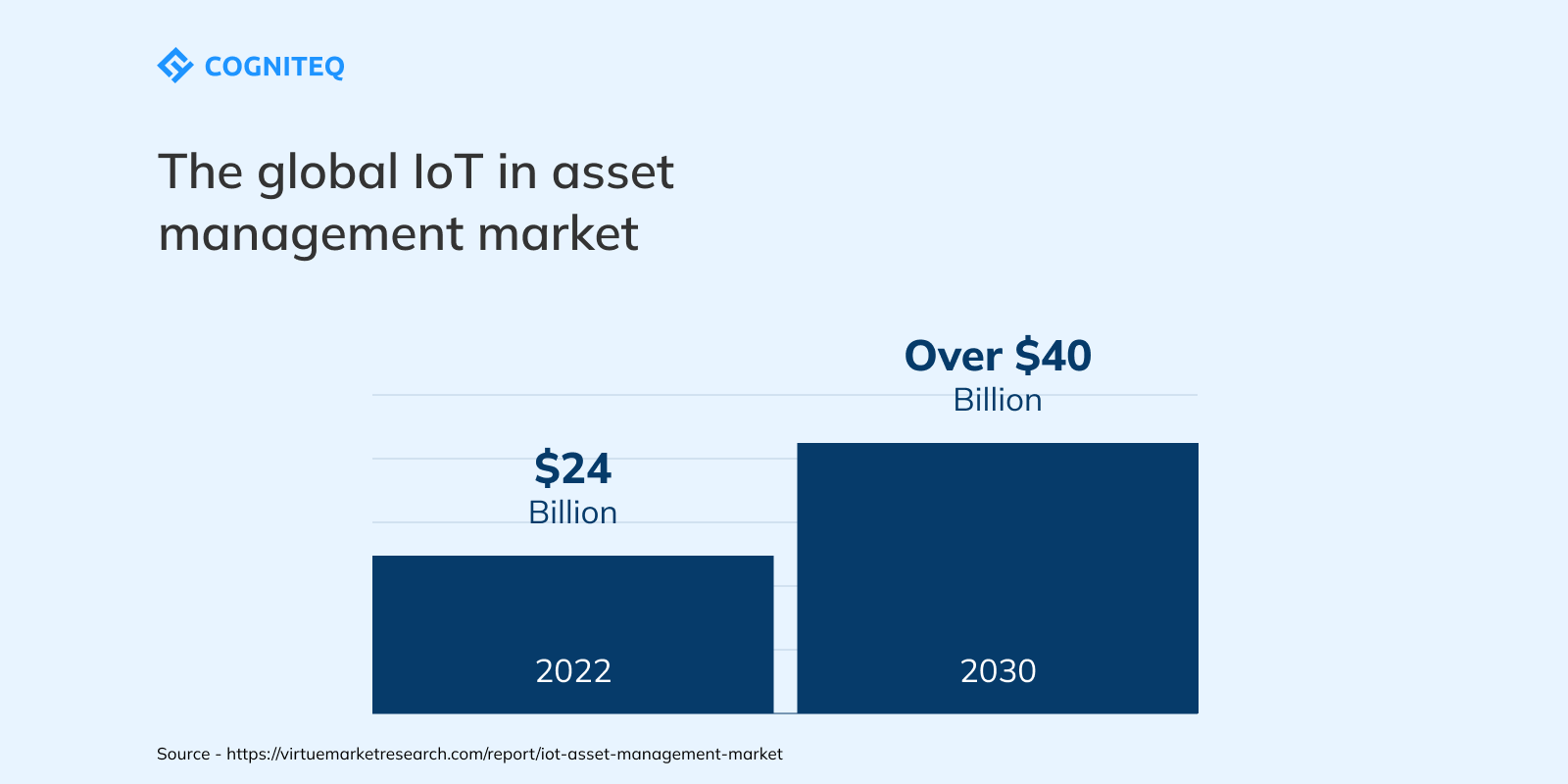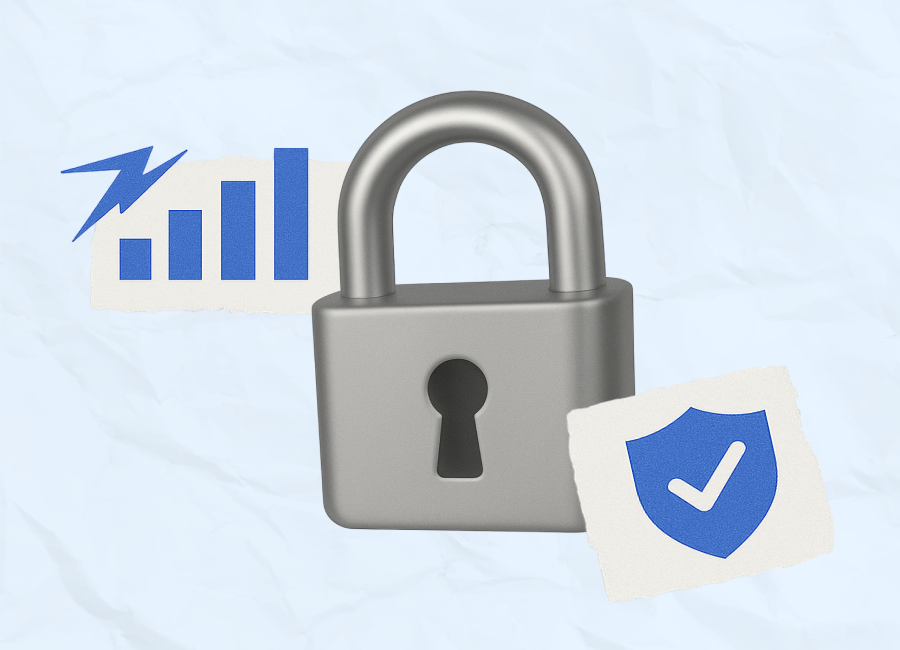Internet of Things solutions are already being applied widely to conduct many business tasks and processes more efficiently. One of those tasks is asset management. A key benefit of using IoT in your system is that it can give you access to a broad variety of important data in real-time. And often that’s exactly what is required to effectively monitor assets: both their status and, in the case of moving assets, their location. In this article, we’ll discuss IoT asset tracking, the advantages of using this technology, and the main principles behind it.
What is IoT-enabled asset management?
IoT-based asset management involves using IoT sensors to control and track industrial and enterprise assets without direct human participation. Such systems not only provide real-time information but also generate valuable business insights.
Applying IoT solutions increases operational efficiency and optimizes a company’s expenses and use of resources.

The global market for IoT in asset management is growing. In 2022, it reached $24 billion, and by 2030 that figure is forecasted to hit more than $40 billion.
How does IoT asset tracking work?
An IoT system for asset monitoring typically includes three main components:
- tracking devices of different types;
- connectivity (for example, WiFi, Bluetooth, WLAN, or a cellular network);
- a software app that allows users to access the accumulated data and manage devices remotely.
Today there are numerous devices that can be brought together in such a system, to gather different types of data. The choice is based on the needs of each particular enterprise. The most popular options are:
- GPS trackers;
- CCTV systems;
- smart locks;
- temperature sensors;
- humidity sensors;
- lighting controls;
- smoke detectors;
- carbon monoxide detectors; and
- Bluetooth Low Energy transmitters.
These solutions usually incorporate the following:
- Step 1. Data collection. Various sensors are placed on physical assets that are part of the system. They gather real-time data related to various parameters (location, temperature, etc.). This data is sent to the cloud platform, where it is processed and accumulated.
- Step 2. Data processing. When the data is received, it needs to be converted into a message that can be viewed by users. The data also needs to be directed to the right place at the right moment. For example, data received from delivery trucks needs to be directed to the logistics department and warehouse facilities.
- Step 3. Data analysis. Your asset tracking system can be enriched with various ML algorithms for efficient data analysis. Machine Learning functionality can help with detecting patterns and providing insights related to the performance of assets and devices.
- Step 4. Report generation. Once the IoT-enabled asset management system has prepared valuable business insights, that information needs to be made available to users. This can be done via a dashboard. Based on the type of data being transmitted, some systems are able to send alerts and notifications in case any urgent measures are required.
Want to introduce your own IoT asset tracking system?
You can fully rely on us for its development and deployment. Our professional IoT team is ready to work on projects of any complexity!
Key benefits of using IoT in asset management
Asset tracking and management are crucial for every business. However, traditional approaches and manual procedures are typically not as efficient as they should be, especially when your managed assets are growing. Many companies are looking for alternative ways to monitor assets using IoT tracking devices and tracking solutions.

IoT-enabled asset management brings convenience. But that’s not all. Let’s take a look at the advantages of IoT-based asset management in more detail.
- Real-time data transmission. Thanks to IoT sensors, it is possible to get access to the most relevant information for real-time asset monitoring. Company employees can easily get the latest data on any asset at any time of any day.
- Ability to track assets remotely. To monitor the location and performance of various items, vehicles, and machinery with IoT asset-tracking solutions, you don’t need to be close to them.
- Access to different types of data. IoT-based asset tracking systems can accumulate data related not only to the location of assets but also to their performance and other factors. These insights can help managers make better informed strategic decisions.
- Better organized supply chain processes. IoT-enabled asset management ensures great visibility at all stages of the supply chain. It means you can plan the next steps with higher accuracy.
- Fewer errors. With IoT asset monitoring, a lot of manual tasks are automated. That means reduced risk of human error.
- Fewer losses and thefts. Thanks to asset tags and other IoT devices, you can track when and by whom your assets are moved. Any unauthorized activity will be detected, which means you have a high chance of reacting in time.
- Predictive maintenance. The capability of AI-powered IoT asset monitoring solutions to track the performance of equipment, detect patterns in its behavior, and identify any sign of deviation lets companies better manage their assets. Thanks to predictive maintenance software, you can stay aware of possible technical issues and risks. As a result, you will be able to take measures to address problems before they lead to significant consequences, such as serious failures and downtime.
Use cases for IoT in asset monitoring
IoT-enabled asset management systems can be of great use in enterprises working in totally different spheres.
IoT-based asset management in logistics and transportation.
When it comes to transporting goods, it’s important to take into account all the recommendations provided by the manufacturer. Many products require specific temperature and humidity controls. To monitor these factors manually may be time-consuming and inefficient. Just asking a truck driver to check the temperature from time to time will be inefficient.
The problem can be solved with the help of the Internet of Things solutions. In this case, tracking devices with temperature and humidity sensors can provide regular data updates, allowing drivers to adjust the temperature or humidity in a truck when required. This helps ensure that products won’t be spoiled during transportation and clients won’t be disappointed.
IoT asset monitoring at healthcare organizations.
Medical centers and hospitals traditionally invest much effort into controlling and tracking their physical assets, including equipment, tools, and other items. It’s vital not only to avoid losses and extra expenses but also to prevent the situation where something goes missing at a moment when it’s urgently needed to save a patient’s life. When hospitals don’t have good tools for tracking assets, staff may waste a lot of time trying to find the necessary equipment.
That’s why solutions such as RFID asset tags can become an excellent choice for monitoring the real-time location of items such as ultrasound units, wheelchairs, and mobile X-ray machines, among others.
IoT-powered systems for fire safety.
Your IoT asset-tracking system can be enriched with smoke detectors. If any sign of fire is detected, the system will direct alerts to the local fire department and/or authorized employees. Alerts can be sent via SMS, email, or an automated phone call. Thanks to the possibility of prompt action, you may save not only your properties but also the lives of your employees.
Our experience in building IoT asset tracking solutions
At Cogniteq, we have strong expertise in creating various IoT-powered systems, as demonstrated by our rich portfolio and recognition among leading IoT companies. One of the projects that we have worked on was the development of the IoT mobile app for tracking assets in emergency vehicles.

Our client had a plan to deliver a solution that would make inventory management for emergency service staff as simple and quick as possible. To achieve this goal, it was decided to build an app that would let users track assets with the help of Android smartphones and Bluetooth LE beacons that could continuously send heartbeat signals to the app.
The first version of the app has the required functionality for viewing and editing the list of vehicles and the list of assets in each of them, for getting access to the signal strength history of the asset, as well as for scanning all discoverable Bluetooth devices.
The solution is currently in a closed beta stage, and our team is gradually introducing new features based on the feedback received during testing. You can learn more about the case here.
Conclusion
The Internet of Things can greatly facilitate and enhance asset tracking. Though implementing an IoT-based system will require investment, these solutions can help optimize your operating costs in the future and avoid expenses related to asset damage, loss, or theft.
But to be sure you will be able to fully leverage all possible advantages of IoT in asset management, you need a solution that fully meets your business needs. Custom development may be a good solution. If you’re looking for developers who will help you realize your project, we at Cogniteq are always at your disposal. Just let us know that you need our professional help and we’ll help you find the right approach to addressing the issues.
FAQ
What is IoT asset management?
IoT-based asset management involves applying Internet-enabled devices and location-tracking tools for monitoring the location, state, and performance of various assets such as machinery, equipment, and vehicles. IoT devices and sensors can also transmit important information about the assets, such as their serial number, operating system, usage, etc.
How is IoT used in asset monitoring?
IoT asset-tracking solutions provide real-time insights into the location of the chosen items and their performance (if this factor is relevant). Thanks to getting accurate data regarding the location of assets, businesses can build more efficient logistics processes and minimize the risk of losing valuable items.























































